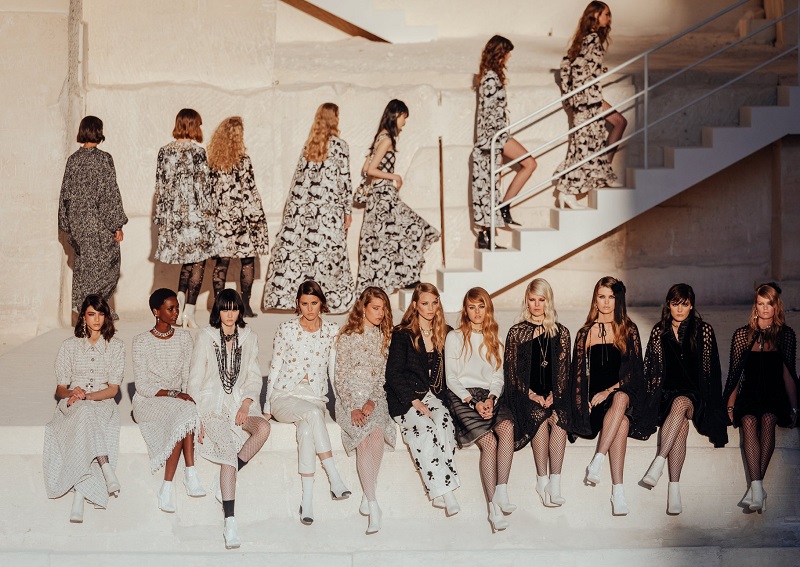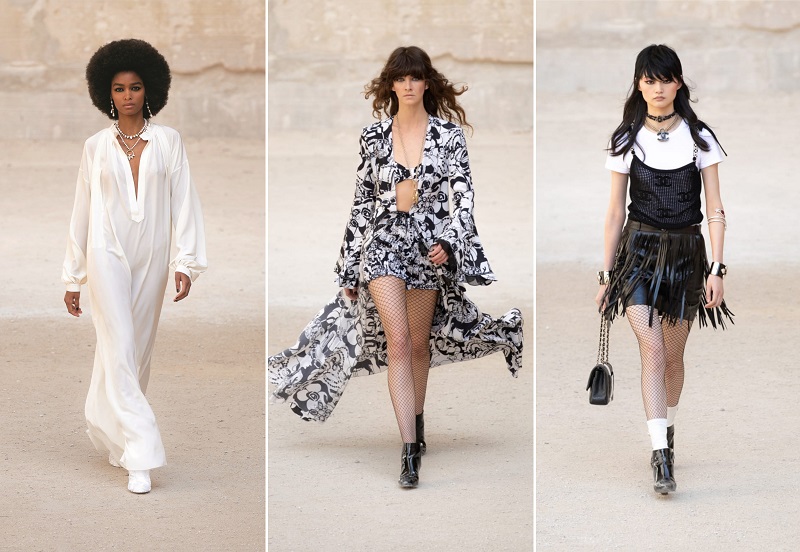
Creative director Virginie Viard played with contrasting hues and punk-rock details like fringes, leather, beads and sequins (All photos: Chanel)
Originally meant for seasoned jet-setters going on cruises (such as the North Americans) or vacationing in the warm Mediterranean area (à la the Europeans) during the winter months, cruise collections offer light spring or summer clothing when the weather at the points of sale actually calls for cold winter wear.
In the last two decades or so, fashion maisons have designed their cruise collections a little differently as travel became an any-time-of-year activity. Rather than a holiday-specific wardrobe, such collections gave maisons the chance to express a lighter, more exuberant aspect of its DNA, which made these smaller collections suitable for both home and the holidays.
With travel not yet possible and therefore less of a consideration, fashion has gone back to the drawing board, if you will, to seek inspiration. When in lockdown, as many parts of the world are, all we can do is fantasise about far-flung lands and forbidden travel. Cruise collections these days draw references from the timeless — and lockdown-independent — worlds of art, cinema and TV, playing up elements of fantasy, fun and fascination.
chanel.jpg

Iconic French legacy brand Chanel has harnessed the power of cinema a great deal in its recent collections and campaigns, heavily referencing the film noir style of the 1950s. For its spring/summer 2021 show, a surrealist black-and-white teaser opened on the iconic Hollywood sign in Santa Barbara, reconfigured as a giant CHANEL, then skimmed across the Hollywood grounds with a magical mash-up of cult Nouvelle Vague movies — including Jacque Deray’s La Piscine and Pierret Le Fou by Jean-Luc Godard.
For its recent autumn/winter 2021 collection, creative director Virginie Viard assembled memories of the late Karl Lagerfeld that Dutch photography duo Inez van Lamsweerde and Vinoodh Matadin translated into film. The collection highlighted tweed coats with structured shoulders and the chevron motif on models walking across the streets, with footage including some of them getting ready at Castel, the resto-bar where the film was shot.
For the cruise season, Viard drew inspiration from the French-est of the French, multi-talented artist Jean Cocteau. Gabrielle Bonheur “Coco” Chanel and Cocteau were great friends — she was the pioneering couturier and entrepreneur; he was the multi-disciplinary artist, poet, playwright and filmmaker. Both influenced early 20th century culture, and they often worked together, too. Coco costumed a handful of Cocteau’s plays and would sketch her designs, and they would spend time together at her Paris apartment, remaining in contact throughout their lives.
chanel_cruise.jpg

“Gabrielle Chanel was close to Cocteau, and I love the film Testament of Orpheus. In particular, this magnificent scene: A man with a black horse’s head descends into the Carrières de Lumières, his silhouette cut out against the very white walls,” Viard says. This is why Chanel’s cruise show was showcased at the Carrières de Lumières, in Les Baux-de-Provence. The show was highly graphic, “because the simplicity, the precision and the poetry of Cocteau’s film made me want to create a very clean collection, with a very distinct two-tone, made up of bright white and deep black”.
There is nothing better to capture and reflect the light, so loved by Cocteau and Coco, than these contrasts between the radiant whiteness of a long shirt-dress and black macramé capes, between a white tweed jacket embroidered with lucky charms and a black dress in velvet and leather. Viard says: “Echoing the extreme modernity of Cocteau’s film, I wanted something quite rock. Lots of fringes, in leather, beads and sequins, T-shirts bearing the face of the model Lola Nicon like a rock star, worn with tweed suits trimmed with wide braids, and pointed silver Mary Janes. A look that recalls as much the modernity of the 1960s as that of punk.”
Most appropriately, it was in Coco’s recently restored apartment at 31 rue Cambon that Inez & Vinoodh — the duo’s preferred moniker — photographed six outfits for the visual campaign for the collection. “It was there that Gabrielle Chanel housed her favourite bestiary, her lions, female sphinxes, but also deer, which are printed, along with other symbols of the House, on a long negligee-style dress in pink-beige and black crêpe. It was also in this apartment that she received her close friends, including Cocteau,” concludes Viard. “Ultimately, through her friendships, it is Chanel, the woman, that I love more and more: Her life gives us access to characters just as extraordinary as herself.”
Sans the usual contingent of celebrities who would dot any Chanel show, the likes of Lily-Rose Depp, Margot Robbie and Ann Hsu sent encouraging love letters instead. But we are now quite used to Chanel’s digital runway productions — no audience nor spectacle, just brilliant, brilliant clothes. Indeed, the collection felt closer to Coco than ever before with its liberal use of black-and-white, tweed, two-toned shoes and generous layers of costume jewellery.
That distinctly punk-rock look may not be an aesthetic often associated with Mademoiselle Chanel, but, in fact, the movement’s rejection of mainstream styles and anti-establishment stance draws many parallels with Coco’s quiet rebellion. And, in many ways, Viard’s too, as she continues to assert her ever-growing confidence and authority, making her mark one collection at a time.
This article first appeared on May 17, 2021 in The Edge Malaysia.


